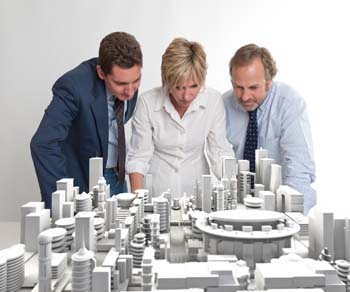IT Architecture Management
 The
IT architecture as part of the enterprise architecture describes the elements
IT uses to support the business. These elements can be applications or
technical elements like networks or databases. IT elements are related
to the elements relevant for the business - business processes and data.
This combination produces typical views on the IT architecture, e.g. applications
used to execute an end-to-end business process or elements processing and
storing specific data objects. The design of the complete IT
architecture is often compared to "City Planning" and respectively you
find terms like "Building Plan" for the IT system landscape.
The
IT architecture as part of the enterprise architecture describes the elements
IT uses to support the business. These elements can be applications or
technical elements like networks or databases. IT elements are related
to the elements relevant for the business - business processes and data.
This combination produces typical views on the IT architecture, e.g. applications
used to execute an end-to-end business process or elements processing and
storing specific data objects. The design of the complete IT
architecture is often compared to "City Planning" and respectively you
find terms like "Building Plan" for the IT system landscape.
 Key task when designing an IT architecture
is to align the architecture sufficiently with business strategy and business
requirements. Often the business strategy is too high-level and does not deliver
enough insight for shaping the IT architecture. Practically proven is an approach
that tries to translate strategic requirements into business processes and
to discuss these with the business. In addition to that it is helpful to describe
development trends with a simple model - the so-called Operating Model
(please check reference A1 for more details). Two dimensions in this model
determine to a great extent how the overall architecture will look like - the
degree of process standardization and the extent of process integration
(Click on graphic to enlarge).
Key task when designing an IT architecture
is to align the architecture sufficiently with business strategy and business
requirements. Often the business strategy is too high-level and does not deliver
enough insight for shaping the IT architecture. Practically proven is an approach
that tries to translate strategic requirements into business processes and
to discuss these with the business. In addition to that it is helpful to describe
development trends with a simple model - the so-called Operating Model
(please check reference A1 for more details). Two dimensions in this model
determine to a great extent how the overall architecture will look like - the
degree of process standardization and the extent of process integration
(Click on graphic to enlarge).
 IT
landscapes have usually grown historically over a long time. A reconstruction
of the IT architecture for a better alignment with business requirements
is then a long-winded and costly procedure. In the beginning the question
"How good does the current landscape support the business" comes
naturally. A solution approach for answering this question is a so-called "Greenfield
Approach". This approach tries to describe the ideal IT architecture
assuming that you had the chance of building it up from scratch. Even
if this ideal is not achieveable it can serve as a benchmark to find out
IT
landscapes have usually grown historically over a long time. A reconstruction
of the IT architecture for a better alignment with business requirements
is then a long-winded and costly procedure. In the beginning the question
"How good does the current landscape support the business" comes
naturally. A solution approach for answering this question is a so-called "Greenfield
Approach". This approach tries to describe the ideal IT architecture
assuming that you had the chance of building it up from scratch. Even
if this ideal is not achieveable it can serve as a benchmark to find out
The service IT Architecture covers the topic as a whole but can be applied to partial architectures as well. Very often the ERP architecture is handled separately and it is examined how a system landscape for a global template with parallel rollouts should look like. The service also offers help on this.
